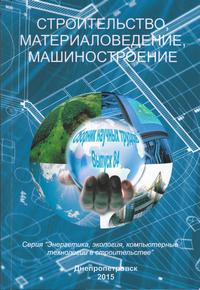To a quastion use fire protection of wood
Keywords:
Fire protection of wood, fireproof paints, intumescent the flame resistant finish combined fire-retardant coating, innovative components of flame resistant finish.Abstract
Purpose.The raised combustibility of wood material, being an essential lack, limits its structural use in building. Continuous workings out of new fireproof means both foreign, and domestic scientists specifies in presence of lacks at existing means and variety of unresolved questions in area flameproofing designs from wood material. The work purpose is revealing of lacks of existing fireproof means for wood material.
Methodology. The state-of-the-art review of the basic groups of the fireproof means raising a limit of fire resistance of wooden building designs is spent, the estimation of their technical characteristics is given.
Findings. The revealed lacks of fireproof means such as: deficiency, dearness, toxicity of many components, limitation of a range of application of means and others that promoted working out of new fireproof means. By authors it is developed fireproof sprout the means providing I group of fireproof efficiency for wood material. Into structure of the specified means enters sprout graphite which possesses heat-insulating and refractory properties, the greatest weight strength at high temperatures, not blow and burns down more difficultly, than diamond.
Originality. It is received new fireproof sprout the means interfering inflow of a surplus heat to the protected surface at the expense of repeated increase in volume.
Practical value. Developed fireproof sprout means gives the chance to use more widely wood material in building and to raise safety of an upkeep of buildings and constructions at the expense of increase in a limit of fire resistance of wood structures.
References
DBN B 1.1-7-2002 "Pozhezhna bezpeka obiektiv budivnytstva". – K.: Derzhavnyi comitet Ukrainy z budivnytstva ta arhitekturi [Fire safety of construction objects". – K.: Ukrainian State Committee of construction and architecture], 2003. – 69 s.
GOST 16363-98 «Sredstva ognezashitnie dla drevesiny. Metody opredeleniya ognezashitnyh svoystv [Means fire retardant for wood. Methods for determination of flame retardant properties]».
A. J. Korolenko, O. N. Korolenko: Spravochnik [Guide]. – M: Pozhnauka, 2009 – 560 s., fig.
Leonovich A. A. Ognezashita drevesiny I drevesnyh materialov: Uchebnoe posobie [Fire protection of wood and wood-based materials: a manual]. – St. Petersburg, 1994. – 148 p.
Sobur S.V. Ognezashita materialov і konstrukciy: Uchebno – spravochnoe posobie [Fire protection of materials and structures: Training manual]. – 5 іzd., pererab. – M.: PozhKnіga. – 2014. – 256 s.
Krashennіkova M.V. Tendencіі і percpectivy razrabotki kompoziciy vspuchivaushihsia ognezashitnyh pokrytiy dlia povyshenia predelov ognestoykosti stroitelnyh konstrukciy [Trends and prospects of development of compositions intumescent fire-resistant coatings to improve fire resistance of building structures] / M.V. Krashennikova //Pozharovzryvobezopasnost [The explosion safety]. – 2008. –№ 2. – S. 36-39
Orlova A. M. Ognezashita drevesiny [Fire protection of wood] / A. M. Orlova, E. A. Petrova // Pozharovzryvobezopasnost [The explosion safety]. – 2000. – т. 9, № 2. – S. 8-17.
Tychino N. A. Sovremennye ognezashitnue sredstva dlia drevesiny: rezultaty issledovaniy [Modern flame retardants for wood: the research results] // Pozharovzryvobezopasnost [The explosion safety]. – 1999. – т. 8, № 3. – S. 13-20.
Romanenkov I. G., Levites F. A. Ognezashita stroitelnyh konstrukciy [Fire protection of building structures]. М.: Stroyizdat, 1991. – 630 с.
Orlova A. M., Petrova E. A. Ognezashita drevesiny. Pozharovzryvobezopasnost [Fire protection of wood. The explosion safety], 2000. – т. 9, № 2, – S. 8-16.
Daniliuc A. New trends in wood coatings and fire retardants. European Coatings JOURNAL – Available at: http: www.european-coatings.com (Accessed 7 August 2012)
Lowden L.A. Flammability behaviour of wood and a review of the methods for its reduction. Fire Science Reviews -а Springer Open Journal. –Available at: http: //www. firesciencereviews. com/content/2/1/4 (Accessed 5 August 2013)
Dedeo M. / Healthy Environments: Strategies for Avoiding Flame Retardants in the Built Environment. A PERKINS+WILL WHITE PAPER. Available at: http: // transparency.perkinswill.com/Content/Whitepapers/PerkinsWill_FlameRertardantAlternatives.pdf (Accessed 15 OCTOBER 2014)
Downloads
Published
Issue
Section
License
Редакція Видання категорично засуджує прояви плагіату в статтях та вживає всіх можливих заходів для його недопущення. Плагіат розглядається як форма порушення авторських прав і наукової етики.
При виявлені у статті більш ніж 25% запозиченого тексту без відповідних посилань та використання лапок, стаття кваліфікується як така, що містить плагіат. У цьому випадку стаття більше не розглядається редакцією, а автор отримує перше попередження.
Автори, в статтях яких повторно виявлено плагіат, не зможуть публікуватися в усіх журналах Видавництва ДВНЗ «Придніпровська державна академія будівництва та архітектури».
Автори, які публікуються у цьому журналі, погоджуються з наступними умовами:
- Автори залишають за собою право на авторство своєї роботи та передають журналу право першої публікації цієї роботи на умовах ліцензії Creative Commons Attribution License, котра дозволяє іншим особам вільно розповсюджувати опубліковану роботу з обов'язковим посиланням на авторів оригінальної роботи та першу публікацію роботи у цьому журналі.
- Автори мають право укладати самостійні додаткові угоди щодо неексклюзивного розповсюдження роботи у тому вигляді, в якому вона була опублікована цим журналом (наприклад, розміщувати роботу в електронному сховищі установи або публікувати у складі монографії), за умови збереження посилання на першу публікацію роботи у цьому журналі.
- Політика журналу дозволяє і заохочує розміщення авторами в мережі Інтернет (наприклад, у сховищах установ або на особистих веб-сайтах) рукопису роботи, як до подання цього рукопису до редакції, так і під час його редакційного опрацювання, оскільки це сприяє виникненню продуктивної наукової дискусії та позитивно позначається на оперативності та динаміці цитування опублікованої роботи (див. The Effect of Open Access).

